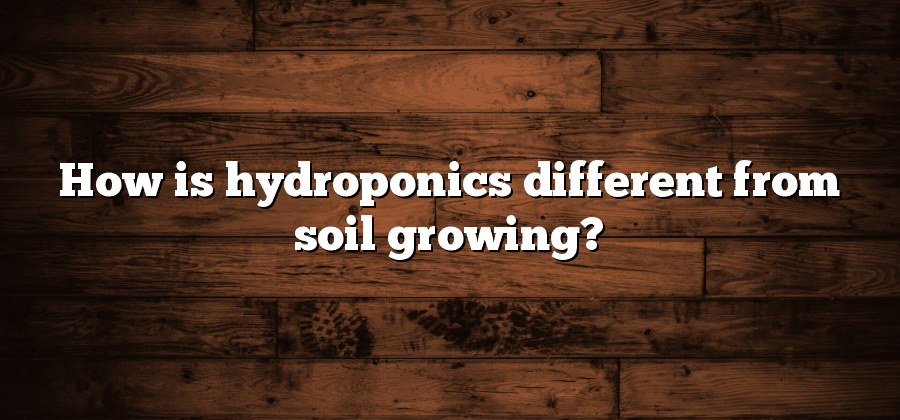– Water Usage in Soil Growing
Water is a precious resource, and in soil growing, it is essential to use it efficiently. Proper water management in soil growing can have numerous benefits, both for the environment and the crops themselves. By utilizing efficient irrigation techniques and smart watering schedules, farmers can minimize water waste while still providing enough hydration for their plants.
One way to conserve water in soil growing is by implementing a drip irrigation system. This system allows for precise water delivery, targeting the plant roots directly and minimizing evaporation. Additionally, using mulch or cover crops can help retain soil moisture, reducing the need for excessive watering. It is crucial for farmers to monitor soil moisture levels regularly and adjust irrigation accordingly, ensuring that the plants receive the right amount of water without overwatering. By adopting these water-saving practices, farmers can ensure the sustainability and longevity of their soil growing operations.
– Resource Efficiency in Hydroponics
Hydroponics is a modern method of farming that presents several advantages in terms of resource efficiency. Unlike traditional soil-based farming, hydroponics utilizes water and nutrients in a highly controlled environment, allowing for enhanced plant growth and reduced resource waste. One key aspect of resource efficiency in hydroponics is water usage. By employing a closed-loop system, water is recirculated and reused, minimizing the amount of water needed compared to traditional farming methods. This not only conserves water but also reduces the strain on natural water sources, making hydroponics a sustainable solution for agricultural production. Additionally, since hydroponic systems are designed to provide plants with the precise amount of nutrients they need, there is less nutrient runoff, preventing soil and water pollution.
In addition to water efficiency, another aspect of resource efficiency in hydroponics is energy consumption. Hydroponic systems often utilize artificial lighting to provide the necessary light for plant growth. While this may require energy, it can be offset by the fact that hydroponics allows for year-round production in controlled environments, eliminating the need for seasonal growing cycles. Furthermore, hydroponic systems can be designed to optimize energy usage, utilizing energy-efficient technologies such as LED lights and automated climate control systems. By harnessing these technologies, hydroponics maximizes resource efficiency and reduces the carbon footprint associated with traditional farming practices.
– Sustainable Agriculture Benefits
Sustainable agriculture offers a multitude of benefits that go beyond just environmental considerations. One of the key advantages is the preservation and enhancement of soil health. By using organic farming practices and minimizing the use of chemicals, sustainable agriculture promotes the natural fertility of the soil. This not only improves crop yield but also ensures the long-term viability of the land for future generations.
Moreover, sustainable agriculture has significant economic benefits. By diversifying crops and implementing efficient irrigation systems, farmers can reduce their reliance on external inputs such as fertilizers and pesticides. This not only cuts down on production costs but also reduces the environmental impact associated with their use. Additionally, sustainable agriculture often focuses on local and regional markets, which strengthens local economies and promotes farmers’ livelihoods.
Harvesting Techniques and Crop Quality
Harvesting techniques play a crucial role in ensuring the quality of crops in soil growing. The careful selection and implementation of harvesting methods can significantly impact the final product’s taste, appearance, and overall market value. It is essential for farmers to consider factors such as maturity stage, post-harvest handling, and environmental conditions when determining the optimal time for harvest. Harvesting too early or too late can result in inferior crop quality, leading to potential losses in the market.
By adhering to proper harvesting techniques, farmers can maximize crop quality and minimize post-harvest losses. One commonly used technique is hand harvesting, which involves manually picking the crops when they have reached their desired maturity. This method allows for selective harvesting, ensuring that only the ripest and highest quality crops are collected. Additionally, careful handling during the harvesting process can help prevent damage and bruising, which can degrade the crop’s appearance and overall marketability.
Another important consideration is the timing of the harvest. Farmers must be mindful of the optimal time to pick the crops to achieve the desired flavor and nutrient content. This is especially crucial for fruits and vegetables, as their taste and nutritional value can significantly deteriorate if harvested too early or left on the plant for too long. The ability to accurately determine the right harvest timing is a skill that experienced farmers develop over time, through careful observation and understanding of crop growth patterns.
In conclusion, proper harvesting techniques and timely harvest play a vital role in ensuring crop quality in soil growing. By employing selective harvesting and mindful handling methods, farmers can maximize the market value of their crops while preserving their taste, appearance, and nutritional content. Continuous improvement in harvesting practices remains essential for sustainable agriculture and meeting the expectations of consumers in an increasingly conscious market.
– Soil Growing and Harvest Timing
Soil growing and harvest timing are crucial factors in ensuring successful crop production in sustainable agriculture. Proper timing allows farmers to maximize the quality and quantity of their yields while minimizing resource usage.
Determining the optimal harvest timing involves a careful evaluation of several factors, such as the plant’s growth stage, weather conditions, and market demand. Harvesting too early or too late can result in underdeveloped or overripe crops, leading to decreased quality and potentially lower market value. Additionally, it is essential to consider the specific requirements of each crop, as different plants have different ideal harvest times. Farmers often rely on visual cues, such as changes in color or texture, as well as experience and expertise to make informed decisions on when to harvest.






